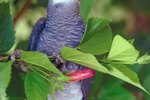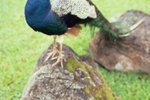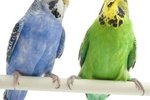
The genus Agapornis includes nine species of the little parrots we call lovebirds. It is difficult to distinguish the sex of lovebirds because they are similar in physical appearance, but males are usually smaller than females. Courtship in lovebirds occurs when the female and male lovebirds attract each other prior to mating, at around 1 year of age. Signs of courtship in lovebirds are easy to observe.
About Lovebirds
Three of the nine lovebird species are often kept as pets. They include Fischer’s lovebird, masked lovebird and peach-faced lovebird. Lovebirds’ original habitat is scrub forests, dry woodlands and savannahs near the equator. Eight of the nine species are found in the wild in Africa, most often at the edge of forests, where they feed on fruits, grasses and seeds. There, lovebirds live in flocks ranging in size from a few birds to more than 800. Lovebirds tend to lay more eggs in the wild than in captivity in captivity -- eight eggs per clutch versus four or five. Most lovebird species pair for life, and they have a lifespan of 10 to15 years.
Proximity of Mates
Lovebird pairs stay close to each other when they're due to mate. The lovebird partners often behave alike, sitting, perching, and sleeping next to each other. The only time they separate is when they are out collecting nesting materials or looking for food. The proximity of lovebirds is a clear sign that that courtship has started.
Grooming
Mutual grooming is another sign of lovebird courtship. The courting pair will groom and feed each other constantly during breeding season and throughout the year. If you are rearing a single lovebird, you will have to provide the social interaction lovebirds need. If you have two lovebirds, make certain you match the pairs well, so they can get along. Seek expert guidance when you choose your lovebird pairs.
Feeding
Lovebirds feed on seeds, nuts, calcium sources, fruits and vegetables for a balanced meal. When courting, the pair will feed each other. Mating often follows when the male feeds the female. The male usually regurgitates to feed the female on the nest before they mate. The female usually initiates this action by lowering herself closer to the perch with her mouth open. All lovebird species engage in courtship feeding.
Nesting
Lovebirds begin to nest after they reach sexual maturity at around 1 year of age. The birds use a variety of materials to build a nesting area. Both sexes take part in building the nest, but the female is better than the male at carrying nesting materials.
References
Resources
Photo Credits
-
Jupiterimages/Photos.com/Getty Images
Writer Bio
Kendal Elizabeth has been a professional writer and editor since 2001. She has specialized in writing pet-related topics, home decor and gardening. Her work has appeared on several online and offline publication. Elizabeth holds a Bachelor of Science in Animal Science with a minor in marine biology from Cornell University.



